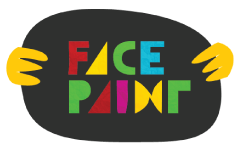
In the Netherlands we don't celebrate Thanksgiving. So when asked to create a Thanksgiving design for this blog, my first step was to explore the internet.
The things that popped up most frequently, were turkeys. For me as an 'outsider' it seems there is no Thanksgiving without a turkey. Keeping that in mind I created this turkey mask and gave it an angry look, because this one definitely doesn't want to be eaten 😉.
Supplies:
Arty Brush cake 'Tigress' (Nat's Gold Edition Collection)
Kryolan Chisel Brush 'DreamBlend' (sub 1/2" FIlbert Brush)
Wiser's Graffiti Madness Stencil Kit

Step 1: Sketching the design on the face
The inspiration for this turkey mask came from a small cartoon image. Trying to find the correct placement on the face I first made a rough sketch on a practice board. Then I adjusted some features of the original image so it would fit better on the face. Because this was my very first attempt on a real face I started the design on the face with a quick sketch too, using a light color.

Step 2: Filling in the base
After adjusting to sketch where needed so the design would have a proper placement, I filled in the sketch with the different colors.
Starting with the beak, using a 1/2 # angle brush and the lightest colors of the 'Mexico' funstroke. Next I picked up the 5/8# angle brush and arty cake 'Tigress' and filled in the head. Starting with the outlines, with the black on the outside. The empty space on the forehead I filled in later, using only the lightest (golden) color on the brush.
For the snood (nose dangle) I used a chisel brush and a bright red paint.

Step 3: Outlining
Next step is outlining the entire design and adding some important features (nose, mouth), using a round brush #3 and some regular black paint.

Step 4: Adding texture, shading and highlights
To make it less cartoony and a bit more realistic I started shading the edges and places where I thought it had to be darker using a small dry blending brush and some black star blend powder.
Next I added some texture to the head with a stencil, using two different colors. On the 'shadow' parts I used dark brown, on the 'highlight' parts I used a mixture of yellow and white. The middle part of the beak I highlighted with a sponge using the same mixture.
The final step consisted of adding white highlights, using a glycerin based white paint and a round brush #5.

Step 5 (optional): Adding a bit of white on the eyes
Because a lot of kids, especially boys, don't like paint around their eyes, I always try to avoid that. In this case I did too, but because my original cartoon image had big white eyes, I added just a little bit of white Starblend powder to the sides, beneath the painted 'brows'. The powder is very soft and dry and doesn't feel annoying.

Additional info:
Like with all designs, proper placement makes it look even better. While sketching this one I tried to let the different focal points (FP) 'guide' me.
For example: the brow- and beak lines are directed to the central FP. The snood I painted a bit longer so I could place it in a nice curve (through the cheek FP, not in the picture), directing it to the chin FP. I also painted it on the opposite site of the feathers on top of the head to keep the design balanced.
Hope you will have lots of fun with this design! I certainly had 😁!
Annabel Hoogeveen is the owner and founder of 'Blije-Snoetjes Kinderschmink', a Facepainting company and school in the Netherlands. She is painting for about 10 years and is passionate about teaching others how to facepaint, 'because the more face painters there are, the more kids we can make happy'.
Annabel likes colorful and easy 'on-the-job' designs. But, as a former vet, she also has a passion for painting realistic 3D animals.
She is an instructor at Olga Murasev's International Face Painting School (www.facebodyart.com), has written several Facepainting blogs and recently won the 'Black Panther' competition here at Facepaint.com.
You can see more of her work on her Instagram and Facebook pages.




